|
Special Features





Image Libraries


|
|
Blog
|
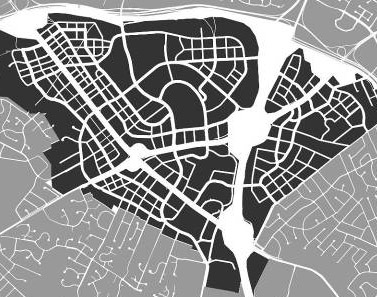
Tysons grid of streets, no. 2. |
Maryland and Virginia will both enact major new transportation funding bills this year. Neither bill says exactly which projects will be funded, but here are the top 10 projects in Maryland and Virginia that most deserve to get some of the funds.
Number 1: 8-car Metro trains. Metrorail is near capacity, especially in Virginia. More Metro railcars would mean more 8-car trains on the Orange, Blue, and Silver Lines.
Number 2: Tysons grid of streets. Tysons Corner has more office space than downtown Baltimore and Richmond put together. Converting it to a functional urban place is a huge priority.
Number 3: Purple Line. Bethesda, Silver Spring, Langley Park, College Park, New Carrollton. That’s a serious string of transit-friendly pearls. The Purple Line will be one of America’s best light rail lines on the day it opens.
Number 4: Baltimore Red Line. Baltimore has a subway line and a light rail line, but they don’t work together very well as a system. The Red Line will greatly improve the reach of Baltimore’s rail system.
Number 5: Silver Line Phase 2. The Silver Line extension from Reston to Dulles Airport and Loudoun County is one of the few projects that was earmarked in Virginia’s bill, to the tune of $300 million.
Number 6: Arlington streetcars. The Columbia Pike and Crystal City streetcars both have funding plans already, but could potentially be accelerated.
Number 7: Route 7 transit. Leesburg Pike is the next Rosslyn-Ballston corridor waiting to happen. Virginia is just beginning to study either a light rail or BRT line along it.
|

Corridor Cities Transitway, no. 8. |
Number 6: Corridor Cities Transitway. Gaithersburg has been waiting decades for a quality transit line to build around. BRT will finally connect the many new urbanist communities there, which are internally walkable but rely on cars for long-range connections.
Number 9: MARC enhancements. MARC is a decent commuter rail, but it could be so much more. Some day it could be more like New York’s Metro North or Philadelphia’s SEPTA regional rail, with hourly trains all day long, even on weekends.
Number 10: Alexandria BRT network. This will make nearly all of Alexandria accessible via high quality transit.
Honorable Mentions: Montgomery BRT network, Potomac Yard Metro station, Virginia Beach light rail, Southern Maryland light rail, VRE platform extensions.
 Cross-posted at Greater Greater Washington. Cross-posted at Greater Greater Washington.
Average Rating: 4.5 out of 5 based on 216 user reviews.
April 3rd, 2013 | Permalink
Tags: BRT, commuterrail, funding, government, lightrail, metrorail, roads/cars, streetcar, top10, transportation

|
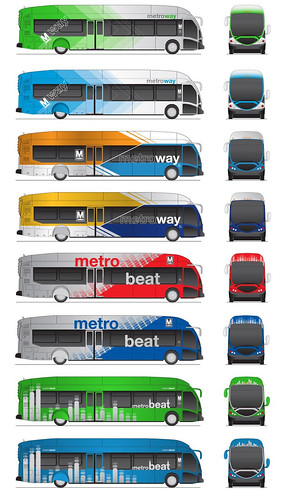
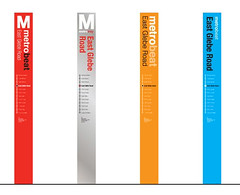
Potential WMATA BRT brands. |
The Washington region’s first BRT line will open in 2014, running from Crystal City to Alexandria. It will have a dedicated transitway, stations rather than stops, and other amenities above and beyond any other bus line in the region. It will need a fresh brand; WMATA’s MetroExtra look won’t do, since MetroExtra is a much more limited service than BRT.
Thus, WMATA has proposed 2 potential names, and 8 possible paint schemes.
All the paint schemes are vivid and colorful, which is a good thing. High quality services should stand out, so a bright bus livery is appropriate.
My favorite is the blue arrowhead option. The forward-facing arrowheads impart speed, and the blue ties back to MetroExtra, relating WMATA’s 2 premium bus brands under a similar banner.
I’m not a huge fan of either proposed name. Both MetroWay and MetroBeat seem forced, and arbitrary. MetroBeat especially runs the risk of being read as Beat Metro, an unfortunate pun sure to be used mockingly any time something goes wrong.
I’d prefer MetroRapid, a brand Los Angeles uses for a premium (but non-BRT) service that’s similar to WMATA’s MetroExtra.
WMATA also proposes 4 potential pylon options for use at stations. I prefer the options without the large capital M, which I think look a little too similar to Metrorail pylons. But all 4 are good.
If you want to share your opinion about these proposals, WMATA has a survey.
Average Rating: 4.4 out of 5 based on 173 user reviews.
March 11th, 2013 | Permalink
Tags: BRT, bus, transportation

Denver is in the midst of a huge regional rail expansion. That’s great, but like in many cities (including DC, historically), the urban bus system has been largely ignored amidst all the hubbub over rail.
I got my planning degree at the University of Colorado, and after discussing Denver’s bus system with some friends recently, decided to produce this map. It shows the city’s high-frequency bus routes along with its existing and future rail lines.
Although the geography is obviously different, in many ways this map is a sequel to my DC 15-minute bus map from last August. I applied a lot of the lessons learned during that exercise to this Denver map. Compared to the DC version this map shows more information, presented more cleanly.
Read more at DenverUrbanism.com.
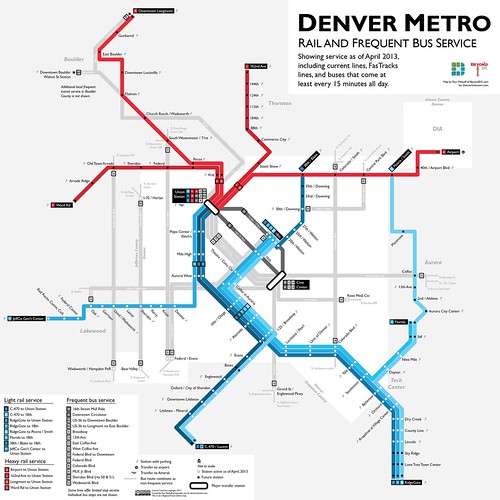
Denver rail and frequent bus map, including future lines. Click map for full size version.
Other sizes via flickr.
Average Rating: 4.5 out of 5 based on 169 user reviews.
February 27th, 2013 | Permalink
Tags: BRT, bus, commuterrail, lightrail, maps, streetcar, transportation

If Maryland’s legislature fails to raise new transportation funding this year, the Purple Line light rail, Baltimore Red Line subway, and Corridor Cities Transitway BRT could all be cut or seriously delayed.
While reading a report about the Corridor Cities Transitway, I stumbled on these renderings of two of its more important stations. The first shows King Farm, near Shady Grove Metro, and the second shows Metropolitan Grove, a TOD in Gaithersburg where the CCT will meet an existing MARC station.
Note the relatively simple brick stop shelters, especially.

King Farm station.
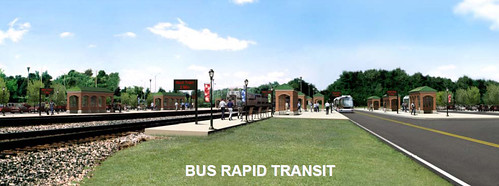
Metropolitan Grove station, showing MARC on the left.
Average Rating: 4.9 out of 5 based on 159 user reviews.
February 26th, 2013 | Permalink
Tags: architecture, BRT, funding, government, transportation

|

K Street Transitway. Image by DDOT. |
DDOT is studying whether or not to extend the H Street streetcar onto K Street in downtown DC. As part of the study, they will rethink whether or not the long-planned K Street Transitway makes sense.
DC’s citywide streetcar plan shows a line connecting H Street with downtown and Georgetown, roughly along the same route as the K Street Circulator bus. With H Street less than a year from opening, it’s now time to start working on the next project.
On Wednesday evening last week, DDOT kicked off its new Union Station to Georgetown Transit Alternatives Analysis. It will consider extending the streetcar versus using other modes such as BRT. It will also look at whether to pursue the transitway or some other alternative.
In order to gain federal approval, and possibly get funding, DC has to study all the options. Streetcars will be strongly considered since existing streetcar plans are the impetus for the study, but rail is not a foregone conclusion.
The study will also look at K Street itself. For years DDOT has proposed rebuilding K Street to include a physically separated transitway down its center. The transitway hasn’t been built yet because there’s never been funding. It’s at least a $140 million project, not counting any of the tracks or electric power systems necessary for streetcars.
The transitway is still an option, but as part of the Alternatives Analysis DDOT will also look at other possibilities, such as curbside transit lanes, mixed traffic, and maybe even using other streets for more transit trips.
The analysis will also consider how to connect Georgetown. Traditional options will focus on Pennsylvania Avenue, M Street, and K Street underneath the Whitehurst Freeway, but a more radical idea might be to convert the Whitehurst itself to a more multimodal, complete street.
If you have any ideas you think DDOT should consider, you can contact them via the project webpage.
Average Rating: 4.8 out of 5 based on 278 user reviews.
February 25th, 2013 | Permalink
Tags: BRT, streetcar, transportation

|
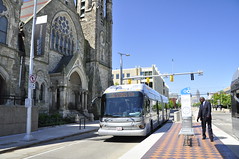
Cleveland’s Health Line, America’s highest-scoring BRT. Photo from EMBARQ Brasil on flickr. |
When new bus rapid transit lines are discussed, proponents often say they hope to make the routes gold standard, meaning so high quality that they mimic many features of rail. That’s a high bar; most BRT projects in the United States don’t even qualify as true BRT, and so far not one has actually met the gold standard.
The Institute for Transportation & Development Policy publishes BRT standards that describe minimum characteristics necessary for a bus route to qualify as BRT. Those standards establish three levels of BRT quality: bronze, silver, and gold. They include features like off-bus fare collection, high station platforms, and bus frequency.
So far, only 5 lines in the United States have scored highly enough to qualify as true BRT, and all 5 rank at the bronze level. Not one is even silver, let alone gold.
According to ITDP, the best performing BRT systems in the world are Bogota, Colombia and Guangzhou, China, which score 93/100 and 89/100, respectively. They are the gold standard.
By comparison, the United States’ highest-scoring BRT route is Cleveland’s Health Line, which hits bronze with a score of 63. The other 4 bronze BRT lines in there US are in Eugene, Los Angeles, Pittsburgh, and Las Vegas.
Boston’s famous Silver Line, which even runs in a subway for a short stretch, scores a meager 37. That’s not enough to qualify as true BRT at all, even a low level.
It isn’t that gold standard BRT is impossible in the United States. Certainly it’s possible. But it isn’t built here because nobody really wants to build it.
The same community leaders who choose BRT over rail because BRT is cheaper then make the same choice when faced with other potential cost-cutting measures. They eliminate the most expensive features, until the gold standard that was promised isn’t actually what’s delivered.
That sort of feature cutting is called BRT creep, and so far it’s happened to some extent on every major BRT project in American history.
None of this should suggest that BRT is worthless. Sometimes BRT creep can even be beneficial, if it makes an otherwise infeasible project possible. Bronze level BRT is still rapid transit, after all, and even bus priority routes that don’t fully qualify as actual BRT are often a huge improvement over regular busing.
WMATA’s MetroExtra service, for example, isn’t usually called BRT even by low American standards, but it’s still a great service. It was something Metro could do quickly and cheaply to help riders, and it works.
But beware the politician who argues for gold standard BRT over rail. Odds are they won’t deliver.
 Cross-posted at Greater Greater Washington. Cross-posted at Greater Greater Washington.
Average Rating: 4.6 out of 5 based on 235 user reviews.
January 17th, 2013 | Permalink
Tags: BRT, transportation

Tysons Corner has more office space than downtown Baltimore, Richmond, and Norfolk put together. It should be the center its own large transit network. The Silver Line and express buses on the Beltway HOT lanes are good first steps, but in the long run Tysons is going to need more routes, connecting it to more places.
In the long run, Tysons needs something more like this:
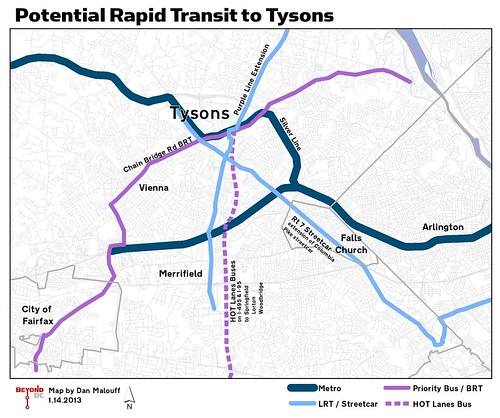
In recent years, planners in Virginia have begun to seriously consider a Tysons-centric rapid transit network. It doesn’t have a name, and isn’t officially separate from any of the other transportation planning going on in the region, but it shows up on long range regional plans like SuperNoVa and TransAction.
In addition to the Silver Line, HOT Lanes Buses, and Tysons’ internal circulation network, officials are beginning to study light rail connections to Maryland, Falls Church, and Merrifield, and BRT on the Chain Bridge Road corridor.
It will be years before any of these additional routes are implemented, and they could look very different from this map once they finally are. Details don’t exist yet, because at this point these are little more than ideas.
But to work as the urban place Fairfax County officials hope Tysons will become, this is the sort of regional infrastructure it’s going to need.
 Cross-posted at Greater Greater Washington. Cross-posted at Greater Greater Washington.
Average Rating: 4.4 out of 5 based on 207 user reviews.
January 14th, 2013 | Permalink
Tags: BRT, bus, lightrail, metrorail, streetcar, transportation

Arlington has two streetcar projects in planning. Columbia Pike has been in the works longer and received more press, but Crystal City is no less important. When they’re both up and running, they’ll most likely operate as a single line.
One key difference between them is that the Crystal City line will run in its own right-of-way, meaning it won’t have to share lanes with cars. Much of its transitway is already in place, and will open as a BRT line before the streetcar is ready.
Here’s the first rendering of streetcars in Crystal City, released in the project’s November newsletter.
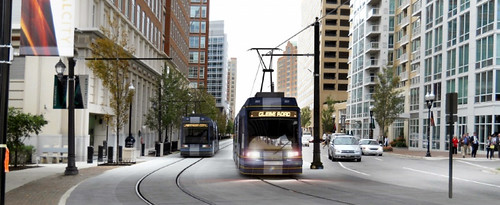
Average Rating: 4.5 out of 5 based on 169 user reviews.
November 30th, 2012 | Permalink
Tags: BRT, lightrail, streetcar, transportation

Last year about this time I visited Seattle, Portland, and Vancouver. I prepared a slideshow of transportation photos from the three cities to share with coworkers. It’s essentially a tour of rail, bus, and bike infrastructure within each city. Why not share it here too?
Click the image to download a pdf of the slideshow. It’s about 16 Mb. If you just want to see the photos in flickr without commentary, here they are.
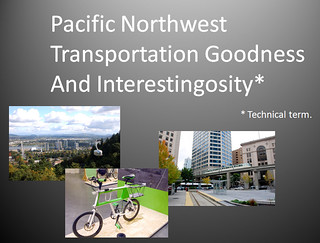
Click to download pdf.
Average Rating: 4.5 out of 5 based on 198 user reviews.
October 16th, 2012 | Permalink
Tags: bike, boat, BRT, bus, commuterrail, galleries, intercity, lightrail, streetcar, transportation

|
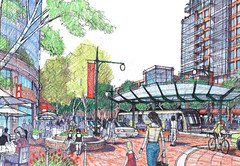
Future Crown BRT station. |
The long debated Crown Farm development in Gaithersburg officially begins construction today. The massive project will include 3, 750 residential units and 320, 000 square feet of retail, and is planned around a future station on the Corridor Cities Transitway. Impressively, it is Gaithersburg’s 5th large new urbanist neighborhood, with a 6th nearby in Rockville.
Unfortunately, construction of the transitway is still years away. But even without the transitway Crown Farm (now dubbed simply “Crown”) will be far superior to typical sprawl. And the transitway will eventually get there.
In the mean time, the first phases of the project will begin. The developers are holding off on the high rises that will be right next to the transit station until the transitway is at least closer to reality, but they’re starting phase 1 now. The plan below shows the various phases.
The pink (mixed use) and orange (residential) phases are what is beginning now. The transit station area, which will ultimately be the densest, will be in the purple phase.
For more images of the pink mixed use section, see JBG’s retail web page. Hat tip to Gaithersburg Patch for breaking the news.
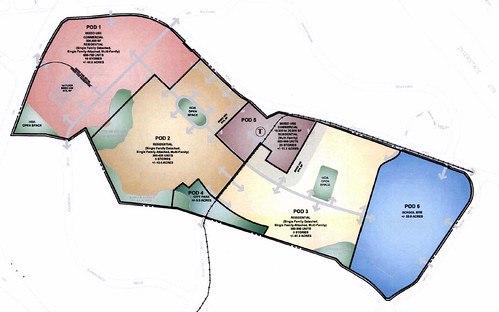
Crown development phasing plan.
Update 1:13 pm 10.11.2012: Reader thisisbossi says construction started months ago. Gaithersburg Patch clarifies that today was the ceremonial groundbreaking.
Average Rating: 4.7 out of 5 based on 195 user reviews.
October 11th, 2012 | Permalink
Tags: BRT, development, transportation

|
Media





Site
About BeyondDC
Archive 2003-06
Contact
Category Tags:
Partners
|


 Cross-posted at Greater Greater Washington.
Cross-posted at Greater Greater Washington.
























